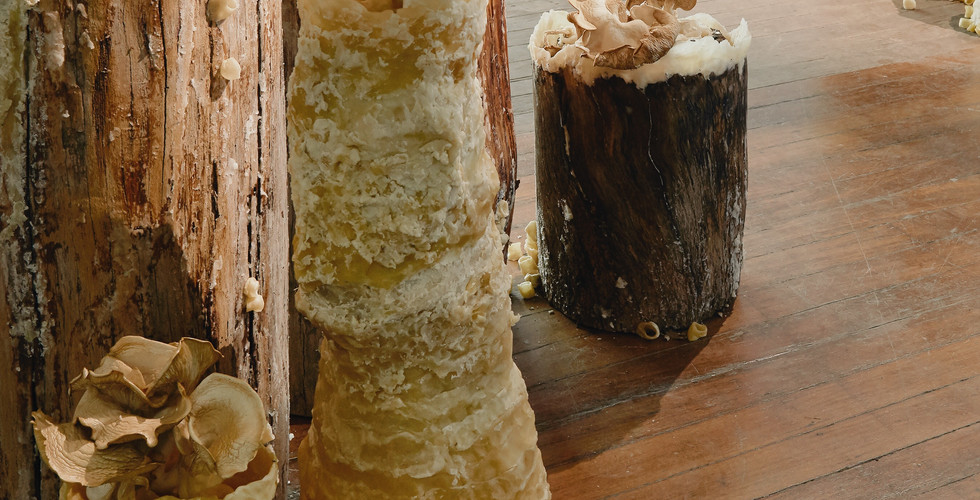Within and Without
- Anthroposphere

- Jun 15, 2019
- 4 min read
Updated: Nov 22, 2019
By Kath Fries

Within and Without is an installation of beeswax and log sculptures which incorporates growing and dried oyster mushrooms (Pleurotus ostreatus) into a larger temporal and corporeal experience. This work invites embodied encounters with these materials, engaging not just the mind but also the body through touch, smell, and movement as well as sight, moving around and within the work. The experience is multisensual: tactile, visual, aromatic, and kinaesthetic. Through these encounters, Within and Without conjures moments of enchantment and reveals processes of time, change, growth, and decay.

These moments of enchantment spring from attentiveness to ecological complexities. Such glimpses of interdependent connections between trees, insects, soil, and fungi become felt absorptions of wonder and delight. To be enchanted is to be touched by a sense of another time and space. The sense of being enchanted by biodiversity, even if only briefly, is to feel a shift away from normative human-centric perspectives and the pervasiveness of capitalist consumption. Being touched in this way opens up felt understandings of the interconnectedness of all life within and around us. Indeed, such emotional engagements are essential in responding to the climate crisis.

The title of the work, Within and Without, indicates how humans are inextricably entangled within the Earth’s complex ecosystems. In the face of global deforestation, pollution and mass species extinction of mammals, plants and insects, plants and fungi; Within and Without reflects on mycoremediation as a process. These forms of bioremediation involve working with fungi-based systems to rehabilitate and decontaminate environments. American mycologist and bio-diversity advocate Paul Stamets has been developing processes for inoculating barren logging roads with fungi spores, helping mushroom mycelium networks spread and rebuild soil nutrition. As he describes in his book Mycelium Running, the introduction of mycelium networks helps to reconnect and gradually regenerate these divided and vulnerable patches of forest. Stamets is also studying the remedial properties of fungi in relation to honeybees (Apis mellifera). Since 2006 there have been dramatic global decreases in domesticated honeybee populations, termed Colony Collapse Disorder. This multi-causal phenomenon has been linked to the honeybees’ weak immune systems caused by pesticides, industrialised agriculture, viruses and parasites, land-clearing and the loss of diverse natural food sources. After Stamets observed honeybees feeding on the moisture droplets secreted by fungal mycelia, he tested extracts from the mycelium of multiple polypore fungal species known to have antiviral properties. His findings indicate honeybee immune systems improve with these fungi antimicrobial compounds.

The combination of beeswax and fungi in Within and Without reflects this connection. Nested crowns of beeswax wreath the standing logs, glowing golden under the lights and smelling honey-sweet. Within these pitted, honeycombed forms oyster mushrooms are fruiting, adding to the layers of aroma: earthy, fungal, and damp beneath the wax’s sweet, oily, and honeyed fragrance. The combination is intriguing, conjuring memories of forest walks. At the same time, the assemblage’s vertical logs are friendly and welcoming, solid echoes of the standing space occupied by their human visitors. Smattered with aromatic melted beeswax, the trunks engender a sense of tenderness, as though inviting embrace.

Over the course of the exhibition, Within and Without houses the oyster mushrooms as they grow in three flushes. As they age, the old mushrooms are left in place to shrivel and dry out - quite different from usual cultivation practices, in which oyster mushrooms grown as a gourmet food product are harvested in their prime. In my art practice, working with living oyster mushrooms is an evolving relationship that anchors the larger assemblage in a continuous process of becoming. This co-creation is immersive, as I develop a responsive and repetitive process; observing and tending to the fungi daily, watering the mycelium, watching the forms mushroom and change as they grow out and over their pitted beeswax casings. I gently touch the changing textures, as mushroom's fragile velvety gills eventually unfurl, drying out into ribbed leathery firm surfaces against their smooth golden beeswaxed nests.

Within and Without invites experiential, embodied encounters, opening up different understandings about how humans both are drawn to and tend to overlook fungi, insects, trees, and the broader biodiversity of forests. My work speculates about how we can become re-enchanted with the interconnected nuances of forest ecosystems, through multisensual encounters - tactile, visual, aromatic and kinaesthetic. This embodied art experience can deepen into a more felt understanding of all life being interconnected within and around us, as we cannot survive without complex and biodiverse ecologies.
Dr Kath Fries is an Australian artist, writer, curator and researcher. She has a PhD from Sydney College of the Arts, University of Sydney. Fries has worked with Sydney Environment Institute and the New Materialism in Contemporary Art research cluster at the University of Sydney. She exhibits widely in Australia and has presented her work internationally at the conference Encountering Materiality: Science, Art, Language, University of Geneva; and residency research projects at Taleamor Park, LaPorte IN, USA and Silence Awareness Existence, Arteles Creative Centre, Hämeenkyrö, Finland. Fries has received a number of grants and awards for her art work. www.kathfries.com
All Photographs: Ellen Dahl
If you like what you've just read, please support Anthroposphere by buying one of our beautifully designed physical copies here. All proceeds go towards printing, designing and maintaining our publication, and your contributions will help keep our climate journalism interdisciplinary and accessible for all.






























Comments